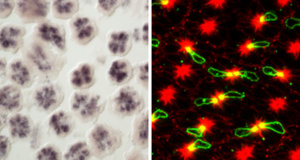Project B3 Spaethe
Developmental timing mechanisms during the formation of the compound eye in the honeybee worker, queen and drone
Summary
A fundamental challenge in honeybee biology is to understand the timing of developmental programmes leading to specific morphological and physiological characteristics of the three castes, which show significant differences in their length of larval and pupal development. The precision of developmental programmes reflects the accurate integration of temporal control mechanisms with those that specify for other aspects of pattern formation, such as spatial and caste information.
This project aims to characterize the developmental mechanisms that pattern the compound eye of the honeybee (Apis mellifera) worker, queen and drone. Spectral composition of compound eyes differ significantly between castes due to task-specific utilization of the visual system; for instance, workers have to find and identify flowers, drones need to detect a receptive queen within a drone congregation area, and queens must locate these drone congregations. In addition, the compound eyes most likely constitute the major light input channel for the entrainment of the circadian clock. Although the casteand sex-specific composition of the compound eyes in bees has been addressed in the past years, almost nothing is known about the underlying developmental processes.
Here we will focus on the temporal mechanisms leading to the cast-specific compound eye patterning. Particular attention is given to the intrinsic factors that determine the spatio-temporal expression of the three opsins forming the light-sensitive part of the compound eye. Based on these results, a time-specific manipulation of identified transcription factors during pupal development may facilitate the construction of eye types which differ in spectral sensitivity and/or ommatidial composition. These “spectral phenotypes” will then allow testing the adaptive value of specific compositions of different photoreceptor types for colour perception and the entrainment of the circadian clock. In particular, the project pursues four main goals:
- To identify the caste-specific timing of transcription factors and opsins during pupal development of the compound eye.
- To identify receptor type-specific co-expression of transcription factors and opsins.
- To set up and test a model of the developmental timetable of opsin expression in the retina and constructing bees with modified eyes (“spectral phenotypes”).
- Using these “spectral phenotypes” to test the adaptive value of specific photoreceptors and ommatidial types for colour perception and their relative contribution for the entrainment of the circadian clock.

Fig. 1: Analysis of the opsinexpression sample with in situ hybridation (left) and immunohitochemistry (right) during the development of the cocoon.





